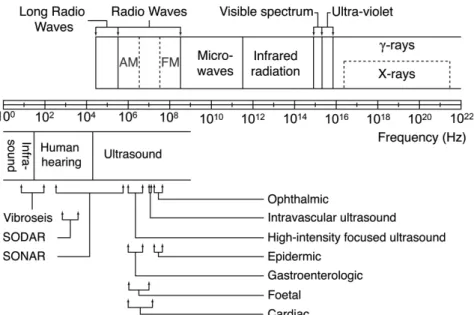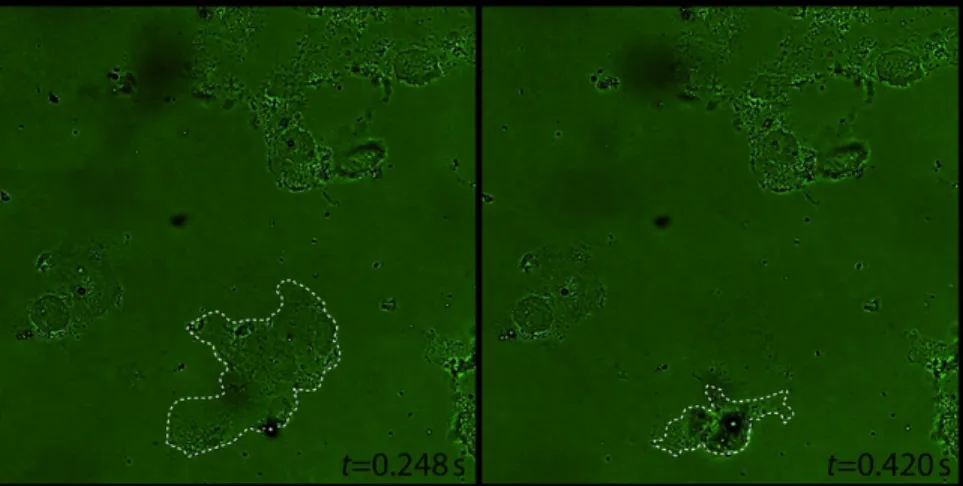HAL Id: hal-03189343
https://hal.archives-ouvertes.fr/hal-03189343
Submitted on 3 Apr 2021HAL is a multi-disciplinary open access archive for the deposit and dissemination of sci-entific research documents, whether they are pub-lished or not. The documents may come from teaching and research institutions in France or abroad, or from public or private research centers.
L’archive ouverte pluridisciplinaire HAL, est destinée au dépôt et à la diffusion de documents scientifiques de niveau recherche, publiés ou non, émanant des établissements d’enseignement et de recherche français ou étrangers, des laboratoires publics ou privés.
On cells and sound
Spiros Kotopoulis, Anthony Delalande, Chantal Pichon, Michiel Postema
To cite this version:
Spiros Kotopoulis, Anthony Delalande, Chantal Pichon, Michiel Postema. On cells and sound. 34th Scandinavian Symposium on Physical Acoustics, 2011, Geilo, Norway. �hal-03189343�
Spiros Kotopoulis, Anthony Delalande, Chantal Pichon and Michiel Postema. On Cells and Sound
Proceedings of the 34th Scandinavian Symposium on Physical Acoustics, Geilo 30 January – 2 February, 2011.
ON CELLS AND SOUND
Spiros Kotopoulis 1, Anthony Delalande 2, Chantal Pichon 2, Michiel Postema 1,2,3 1 Department of Engineering, The University of Hull, Cottingham Road,
Kingston upon Hull HU6 7RX, United Kingdom
2 Centre de Biophysique Moléculaire, UPR 4301 CNRS affiliated to the
University of Orléans, rue Charles Sadron, 45071 Orléans Cedex 2, France
3 Department of physics and technology, University of Bergen, Allégaten 55,
5007 Bergen, Norway
Abstract
Ultrasound as a therapeutic means is increasing in popularity, owing to its non-invasiveness and low cost. Biomedical applications include surgery, cyanobacteria eradication, and drug and gene delivery. Recent advances have been associated with the ultrasound-induced formation of transient porosities in cell membranes. These and other applications have been associated with the behaviour of medical microbubbles near cells.
Common methods of studying the dynamic behaviour of microbubbles are high-speed photography and optical microscopy.
Here, we give a brief overview of our fields of study in biomedical ultrasonics, concentrating on bubble–cell interactions.
There are three standards for the safe use of biomedical sound. When introducing bubbles, these safety guidelines may be misleading.
Contact author: Kotopoulis, S, Department of Engineering, The University of Hull, Cottingham Road, Kingston upon Hull HU6 7RX, UNITED KINGDOM, email:
Definition of ultrasound
Sound waves are a form of mechanical vibration. They correspond to particle displacements in matter. Unlike electromagnetic waves, which can propagate in vacuum, sound waves need matter to support their propagation: a solid, a liquid, or a gas. The ear is an excellent acoustic detector in air but its sensitivity is limited to an interval between 20 Hz and 20 kHz. Audio-frequency sound is essential in communication and entertainment. The acoustics of buildings, particularly concert halls, has been the subject of considerable study. Unwanted audio-frequency sound is called noise. The study of noise and noise control is an important part of engineering.
Figure 1: Typical applications of electromagnetic (top) and acoustic (bottom) frequencies.
Ultrasound refers to sounds and vibrations at frequencies above the upper audible limit of 20 kHz to values that can reach 1 GHz, as shown in Figure 1. Consequently, ultrasonics involve higher frequencies and smaller wavelengths than audio acoustics. The highest theoretical ultrasonic frequency that can be generated has been elegantly derived by Kuttruff.1 Consider a crystal consisting of molecules separated by a distance !, through which a monotonous longitudinal wave with speed !! is travelling. The phase difference ∆! between two
molecules is then
∆! =
!"
= 2!!"!!, (1)
where ! is the sound frequency and ! is the wave number. If adjacent masses oscillate in opposite phase, the situation is that of a standing wave. Therefore, the highest theoretical ultrasonic frequency must be the frequency where ∆! = ! or
! = !!
Conversely, infrasound involves sounds and vibrations at low frequencies (below 20 Hz) and long wavelengths. Because the physiological sensation of sound has disappeared at these frequencies, our perceptions of infrasound and ultrasound are different. Ultrasonic waves in fluids and solids are used for non-destructive evaluation. The general principle is to excite and detect a wave at ultrasonic frequencies and to deduce information from the signals detected. Example applications include the detection of flaws and inhomogeneities in solids, SONAR, SODAR, medical imaging, and acoustic microscopy. The medical ultrasound range is between 0.5–100 MHz. Ultrasound as a therapeutic means is increasing in popularity, owing to its non-invasiveness and low cost.
The device used for transmitting and receiving ultrasound is called a transducer. Traditional diagnostic transducers use lead zirconate titanate (PZT) materials to send and receive the ultrasound. The acoustic pressures generated by diagnostic transducers have an upper limit due to de-poling. For some therapeutic applications, where higher acoustic amplitudes are desirable different piezo-electric materials have been investigated, such as lithium niobate.2 The density and compressibility parameters of blood cells hardly differ from those of plasma. Therefore, blood cells are poor scatterers in the clinical diagnostic frequency range. Since imaging blood flow and measuring organ perfusion is desirable for diagnostic purposes, markers should be added to the blood to differentiate between blood and other tissue types. Such markers must be acoustically active in the medical ultrasonic frequency range.
The resonance frequencies of encapsulated microbubbles lie well within the clinical diagnostic range, i.e. 1–10µm. Based on their acoustic properties, microbubbles are well suited as an ultrasound contrast agent.
Cell–ultrasound interaction
It has been proven by numerous groups, that the cellular uptake of drugs and genes is increased, when the region of interest is under sonication, and even more so when an ultrasound contrast agent is present.3 This increased uptake has been attributed to the formation of transient porosities in the cell membrane, which are big enough for the transport of drugs into cells.
Figure 2: Cell destruction due to bubble–cell interaction at sonication time t. Dotted lines indicate the cell membrane.
The transient permeabilisation and resealing of a cell membrane in an ultrasound field is called sonoporation.4 There are five non-exclusive hypotheses for the sonoporation phenomenon.5
Cell death due to sonication has also been reported. This observation has been associated with inertial cavitation, the ultrasound-induced generation and subsequent collapse of cavities.6 Structural damage to a cell by an ultrasound contrast agent is shown in Figure 2.
To study these rapid cell–ultrasound interactions, high-speed photography combined with optical microscopy is required.
Phenomena during a single ultrasound cycle need to be recorded at MHz frame rates whereas slower phenomena such as microbubble dissolution or microbubble translation still require kHz frame rates, as opposed to acoustic streaming and fluid flow.
Biomedical applications
Focused ultrasound surgery (FUS) is based on the application of high-intensity focussed ultrasound (HIFU) to heat tissue to a temperature that causes protein denaturation and coagulative necrosis. Typical lesions have been found to be ellipsoid in shape with typical lengths of 1 cm after 1-MHz ultrasound. FUS is used for treatment of malignant diseases in bone and breast. Smaller lesions are necessary for microsurgery.2
Another use of biomedical ultrasound is cyanobacteria eradication. Cyanobacteria contain gas vesicles that can be disrupted with the aid of ultrasound in the clinical diagnostic frequency range.7
If therapeutic agents can be coupled to the shells of ultrasound contrast agents microbubbles or be incorporated in these microbubbles, and the bubbles could be directed to or into cells with the use of ultrasound, this could imply an economic revolution drug and gene delivery.5
Safety
Figure 3: Guidelines for the safe use of biomedical sound.
There are three standards for the safe use of biomedical sound, two of which are represented in Figure 3. The NATO Undersea Research Centre (NURC) guidelines concern acoustic frequencies up to 250 kHz.8 The mechanical index (MI) has been split up into three regimes, of which MI<0.3 has been considered safe in pregnant women and neonatals.9
The thermal index (TI) refers to the transmitted power divided by the estimated power needed to raise the tissue temperature one degrees Celsius. The use of the TI has been disputed. When introducing bubbles, these safety guidelines may be misleading.
References
[1] Kuttruff, H., 2007. Acoustics: An introduction. London: Taylor & Francis.
[2] Kotopoulis, S., Wang, H., Cochran, C., and Postema, M., 2010, Lithium niobate ultrasound transducer for high-resolution focused ultrasound surgery., Proc. IEEE Ultrason. Symp.
[3] Postema, M., and Gilja, H., 2011, Contrast-enhanced and targeted ultrasound., World J. Gastroenterol., 17(1), 28–41.
[4] Bao, S., Thrall, B.D., and Miller D.L., 1997, Transfection of a reporter plasmid into cultured cells by sonoporation in vitro. Ultrasound Med. Biol., 23, 953–95.
[5] Delalande, A., Kotopoulis, S., Rovers, T., Pichon, C., and Postema, M., 2011, Sonoporation at a low mechanical index., (submitted).
[6] Gerold, B., Kotopoulis, S., McDougall, C., McGloin, D., Postema, M., and Prentice,
P., 2011, Laser-nucleated acoustic cavitation in focused ultrasound,. (submitted). [7] Kotopoulis, S., Schommartz, A., and Postema, M., 2009, Sonic cracking of blue-green
algae. App. Acoust., 70, 1306–1312.
[8] NATO Undersea Research Centre, 2006, Human diver and marine mammal risk mitigation rules and procedures. Technical report, NURC-SP-2006-008.
[9] British Medical Ultrasound Society, 2000, Guidelines for the safe use of diagnostic ultrasound equipment.


